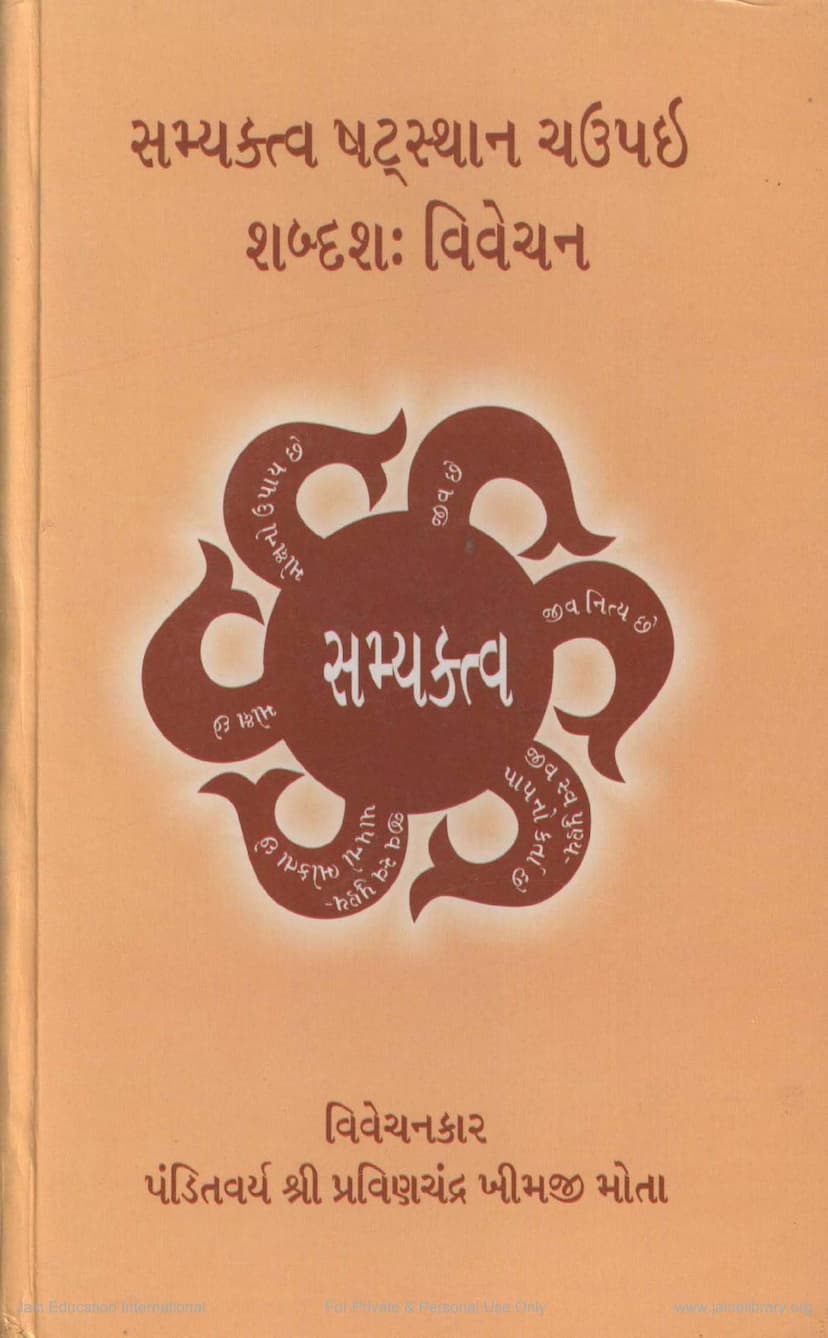Samyaktva Shatsthana Chaupai
Added to library: September 2, 2025

Summary
Here's a comprehensive summary of the Jain text "Samyaktva Shatsthana Chaupai" by Yashovijay Upadhyay and Pravinchandra K Mota, based on the provided pages:
Book Title: Samyaktva Shatst Author(s): Yashovijay Upadhyay, Pravinchandra K Mota Publisher: Gitarth Ganga
Overall Purpose: The book "Samyaktva Shatsthana Chaupai Shabdash: Vivechan" is a detailed commentary and analysis of the work of Acharya Yashovijayji Maharaj, specifically his "Samyaktva Shatsthana Chaupai" (a poetic exposition on the six foundations of Right Faith). The primary goal of the commentary, authored by Pandit Pravinchandra Khimji Mota, is to elaborate on the profound principles of Jain philosophy embedded in Acharya Yashovijayji's original text, making them accessible to a wider audience. The commentary aims to clarify the complex philosophical concepts with scriptural references, logical reasoning, and illustrative examples, thereby aiding seekers in attaining Right Knowledge, Right Vision, and Right Conduct, ultimately leading to liberation.
Core Jain Philosophical Concepts Discussed:
The central theme of the text revolves around Samyaktva (Right Faith) and its six foundational principles, which are presented as six "Sthanas" (foundations or stages). These are contrasted with the six "Mithyatva" (Wrong Faith) principles.
The Six Foundations of Samyaktva (Right Faith):
The text, through Acharya Yashovijayji's work and Pandit Mota's commentary, establishes the following six truths as essential for Right Faith:
- "Jiv Chhe" (The Soul Exists): The existence of the soul (Jiva) as distinct from the body.
- "Jiv Nity Chhe" (The Soul is Eternal): The soul is eternal and does not cease to exist with the dissolution of the body.
- "Jiv Swapunya-Pap no Karta Chhe" (The Soul is the Creator of its Own Merits and Demerits): The soul is the agent responsible for its actions leading to merit (Punya) and demerit (Papa).
- "Jiv Swapunya-Pap no Bhokta Chhe" (The Soul is the Enjoyer of its Own Merits and Demerits): The soul experiences the consequences of its own actions.
- "Moksha Chhe" (Liberation Exists): Liberation (Moksha) is a real state of existence.
- "Moksha no Upay Chhe" (There is a Path to Liberation): There are means or paths to achieve liberation.
The Six Principles of Mithyatva (Wrong Faith):
The text also elaborates on the opposing viewpoints that constitute Wrong Faith:
- "Jiv Nathi" (The Soul Does Not Exist): Denial of the soul's existence.
- "Jiv Nitya Nathi" (The Soul is Not Eternal): The soul is impermanent or non-eternal.
- "Jiv Swapunya-Pap no Karta Nathi" (The Soul is Not the Creator of its Own Merits and Demerits): Denial of individual agency in actions and their consequences.
- "Jiv Swapunya-Pap no Bhokta Nathi" (The Soul is Not the Enjoyer of its Own Merits and Demerits): Denial of experiencing the consequences of actions.
- "Moksha Nathi" (Liberation Does Not Exist): Denial of the possibility or existence of liberation.
- "Moksha no Upay Nathi" (There is No Path to Liberation): Denial of any means to achieve liberation.
Methodology of the Text:
- Refutation of Opposing Philosophies: The book systematically refutes various philosophical schools that contradict the six foundations of Samyaktva. It specifically addresses and refutes the views of:
- Charvaka (Nastika): Deniers of the soul, afterlife, merit/demerit, and liberation.
- Buddhism (Anityavada/Kshanikavada): Those who believe in the impermanence and momentary nature of existence, including the soul.
- Samkhya and Vedanta: Philosophies that view the soul as inactive, not the creator or enjoyer of actions, and whose concepts of liberation are also critiqued.
- Anupayavadi: Those who believe in fate or destiny, denying the efficacy of effort or means for liberation.
- Use of Logic and Scriptural Evidence: The commentary emphasizes the use of rigorous logic (Yukti) and scriptural proofs (Agam Vachana, Shastra Patha) to establish the validity of Jain principles.
- Clarity and Accessibility: Acharya Yashovijayji's original Chaupai and his own commentary ("Balavabodh") are further elucidated through Pandit Mota's detailed "Shabdash: Vivechan" (word-for-word commentary) to ensure deep understanding. The commentary employs numerous examples and analogies to make profound concepts understandable.
- Emphasis on Syadvada: The text highlights the Jain principle of Syadvada (multi-faceted truth) as the means to reconcile seemingly contradictory viewpoints and arrive at the complete truth.
- Structure: The book is meticulously structured, with each Chaupai or verse being analyzed in detail, including its introduction, the original verse, its meaning, the Balavabodh (child's understanding commentary), and the detailed explanation of the subject matter.
Key Highlights and Contributions:
- Elucidation of Samyaktva: The book provides a thorough understanding of the essential beliefs that form the bedrock of Jain faith.
- Intellectual Rigor: It showcases the logical framework and scriptural basis of Jainism, engaging with and refuting other philosophical systems.
- Spiritual Guidance: The ultimate aim is to guide the reader towards a correct understanding of reality, leading to spiritual progress and liberation.
- Commentarial Excellence: Pandit Mota's commentary is praised for its systematic approach, clarity, and comprehensiveness in explaining the intricate concepts of Acharya Yashovijayji's work.
- Preservation of Knowledge: The publication ensures that the valuable teachings of ancient Jain scholars are preserved and made available to current and future generations.
In essence, the "Samyaktva Shatsthana Chaupai" with its comprehensive commentary is a profound treatise that systematically establishes the fundamental truths of Jainism, dismantling opposing views through sharp logic and scriptural authority, and guiding the earnest seeker towards the path of righteousness and ultimate liberation.